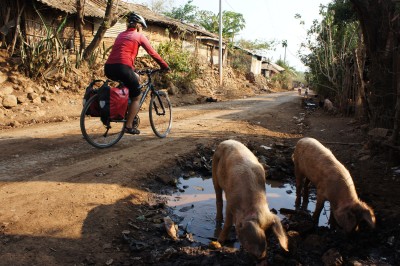
El Salvador: A Country Off the Beaten Track
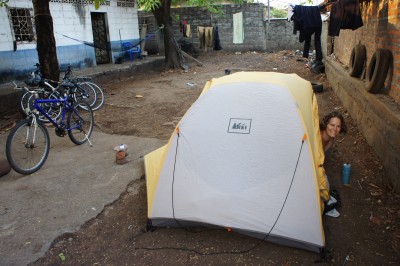
A Night at a Police Station
I never thought I would spend a night at a police station. But life has a tendency to surprise you, especially on cycling trips, when in the morning you never know where you will spend the night. Sometimes you end up in a beautiful garden surrounded by mango trees, sometimes in a sex hotel and sometimes in a police station.
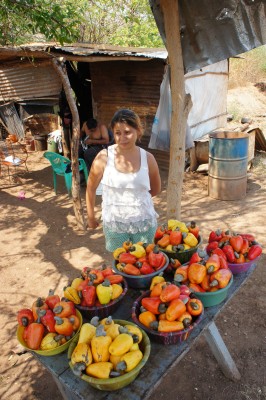
We crossed the border from Honduras at El Amatillo, entering an extremely poor area of El Salvador. We passed through desert like scenery with not much on the side of the road. There were no towns with accommodation in sight, so when we passed a small village we asked some locals if we could camp in their yard. Previously it worked with no problems, but they said there are many thefts in the area and that we wouldn’t be safe. The safest option they thought of was to take us to the police station.
It was probably one of the longest nights of our life. We set up our tent in the middle of the closed courtyard, and the problem wasn’t the 20 armed cops and soldiers around us, who were carrying loaded M-16’s, they were friendly enough, the problem was the heat. Somehow the night passed and the morning came and we could finally carry on.
Social Gaps
At first sight El Salvador seemed very depressing to me. Luckily we spent close to three weeks there, so this impression was turned upside down. Every place has social gaps, but for some reason they seemed more vivid in El Salvador, maybe because usually we don’t meet the upper class.

When we were on Playa Esteron we got friendly with a woman who owns a beach house there. They came there from their permanent home in San Miguel for a week’s holiday. They arrived in two separate cars with a cook, a maid and their grandson. One day they went horseback riding at a ranch that they also own.
In stark contrast, on our second day of riding we came across a row of flimsy tin shacks on the side of the road, the worst we have ever seen. Everyone was selling colourful maranyones, the cashew nut fruit. One family invited us for maranyon juice and freshly made mango jam and told us their story. Apparently the 87 families were all living on a hill not far from there. One day someone bought the property and even though they had lived there for 16 years they had no legal title and were forcefully evicted. They are waiting for a legal action supposedly happening in June, but I don’t know if it has much hope.
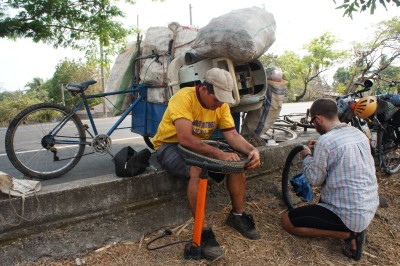
We also met Norberto who was cycling with a huge pile of plastic bottles in front of him. We took a short break and when we passed him again he was pushing his heavy bike since he got a flat tire. Gili kindly offered to fix it for him. He collects plastic bottles on a daily basis from the side of the road, making a few runs to the recycling facility, and earns 6 to 8 dollars a day.
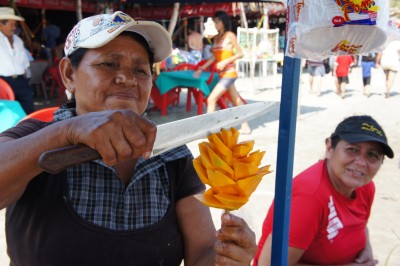
Semana Santa
Our time in El Salvador coincided with Semana Santa (the holy week of Easter). This week is serious business in Latin America and almost everyone had the week off. It meant that places were generally crowded, but it also meant a lot of interesting activity. On Playa El Cuco, where we spent the first part of Semana Santa, there were hundreds of stalls right on the beach selling colourful bowls of shaved ice and flower shaped mangos on a stick, complete with chilli and Worcestershire sauce. There were many locals there all going into the ocean with their clothes on, which seemed to be the way to go in El Salvador.
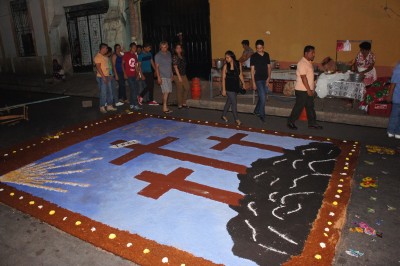
Alegria, which means happiness in Spanish, is a small village in the hills. It is apparently a sleepy place most of the year, but it came very much alive during Semana Santa. In the plaza there were many stalls selling interesting food such as fried yuca served with honey, all catering to local tourists. There aren’t many Western tourists in El Salvador and in fact most of the time we were the only ones there.
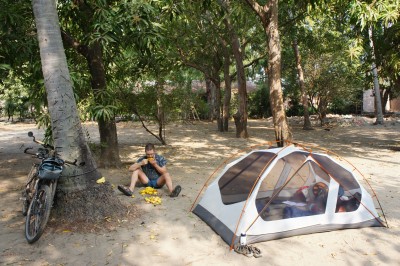
On the holiest Friday of the year we arrived to the town of Zacatecoluca (a real tongue twister). As we cycled into town we saw a group of teens working in the middle of the street to create a colourful “carpet” of Christian elements using salt. A few hours later the city was packed with people marching along the “carpets”. Later on a few dozen white robed people carried the huge casket of Jesus on a procession.
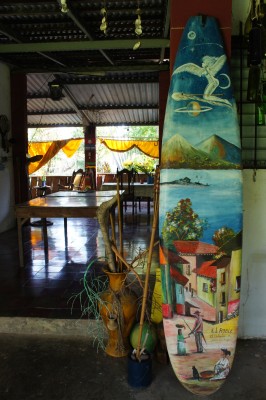
“The Pool Country”
El Salvador has about 300 km of Pacific Ocean coast. In fact, it’s the only country in Central America which doesn’t have a Carribean coast. We spent much of our time in El Salvador following the coastal highway (“La Litoral”). The first stop we made was La Tortuga Verde on Playa Esteron. Although not usually allowed, the owner, Tom, let us pitch our tent on his property, under the mango trees. Every day we would wake up to collect the new mangos and made a pile near our tent. The ocean in El Salvador looked angry with some of the biggest waves I had seen, so in general I preferred the pool. They seemed to like pools in this country and many hotels had much appreciated pools (it was hot!). We started nicknaming it “the pool country”.
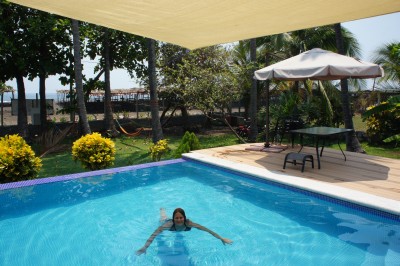
El Salvador is a favorite spot with surfers. We tried surfing a bit in Panama but with much smaller waves. At Playa Esteron Gili decided to try his luck again and rented a board for a couple of hours. I saw him going into the water and surfing a bit in the shallow water. Then I read for a bit and when I looked up again I couldn’t see him anywhere. I jumped from my seat and started searching the ocean. There were a few people in the shallow water but no sight of Gili. A few long minutes after, I finally found him. It turned out that after feeling confident in the shallow water he decided to try the big waves. The big waves took him for a spin and reminded him how forceful the ocean can be. Luckily he survived several “washing machine cycles” and ended up back on the beach, a bit redder than usual.
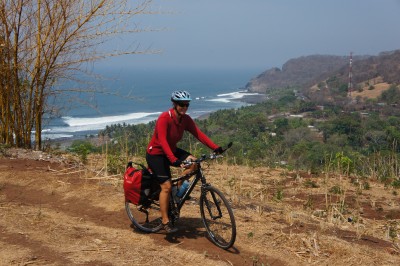
We relaxed for a few days on Esteron, it was after several days of intense riding, and the night at the police station, and we needed the break. Leaving Esteron and the nice pool felt like leaving paradise and I was doubtful that we’d be able to find such a nice place again. That changed a few days later when we made it to El Roble on Playa San Diego.
The hostel was officially closed, unfortunately due to an illness of one of the owners. However, it was unofficially open to those who arrive unexpectedly like us, and we got the royal treatment. They filled the pool especially for us, again we camped in a garden full of mango trees (this time large ones) and we could enjoy the solitude while the hordes were on the beach celebrating Semana Santa.
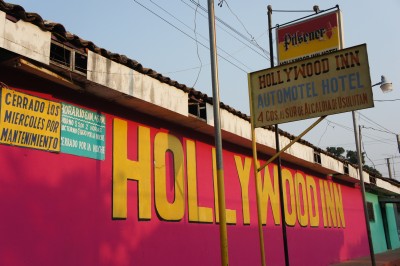
Sex Hotels
In between the nice places we visited we had to spend a few nights in the “in between” places. So we had the pleasure of passing a few nights in Auto Motels, which are very popular in El Salvador. Auto motels/love hotels/sex hotels, your choice of terminology, are hotels where one can park the car in a garage attached to the room and walk into the room with his/her companion without being seen. Most of the action happens during the day for an hourly rate. For a full night we got the special rate of seven dollars (“La Noche Completa”). These places usually had a mirror or two facing the bed, lavishly coloured walls and some special seats. They weren’t the nicest places but they did the job.
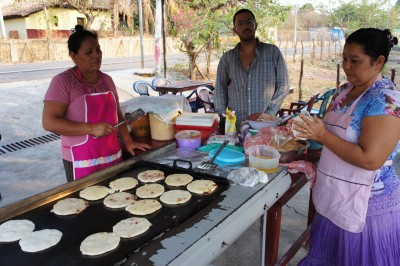
Food
El Salvador offered a blessed change in the culinary scene. The most popular national dish is the pupusa, which is quite an obsession. It’s a flat bread, made of corn or rice dough usually filled with cheese, beans, pork, or everything mixed together. It is made by women only and they shape the dough into a ball, then tap it few times and put it on a flat iron, five minutes for each side. All over El Salvador, we kept on hearing the constant tapping, tap tap tap. The good thing about them is that they are everywhere and no matter where you are, rest assured that someone is making pupusas in a radius of 500 meters or less from you.
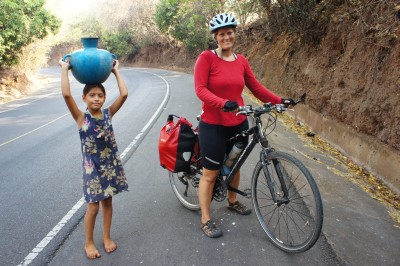
The Riding
The cycling was not the highlight of our time in El Salvador, as we mainly followed one main road. What was nice about the ride though was that the traffic was light and everywhere there were wide shoulders, the best we have seen in any country, often wide enough for us to ride side by side. In the mornings we witnessed the “water march”, people and sometimes children walking to or back from filling up water from a well or the river, invariably carrying the heavy water jugs on their heads. People were also constantly carrying wood logs or stacks of kindling, often on their backs, for cooking purposes.
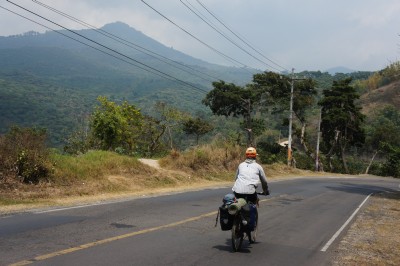
The Hills
We finally left the coastal highway in favour of the “Ruta de Las Flores” (the flower route). A smaller road but a lot of climbing was involved. When we reached Juayua after a 1000 meter climb we felt like we needed a break. We found Casa Mazeta, owned by Darren, the same guy who owns El Roble on Playa San Diego that we liked so much. We got the best room with a private balcony with a lion shaped fountain.
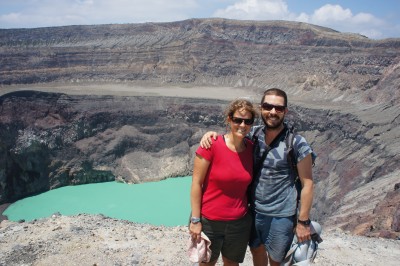
One day we went to a nearby waterfall for a refreshing swim with a local guy named Carlos. The next day we went to Volcan Santa Ana by public transport. Although not too far by distance it took us three and a half hours to get there. We would have never made it back by public transport, but luckily we met a Chinese couple who were driving back to Juayua. Their car did not have seats, the driver, a Chinese guy named Elvis drove fast and braked abruptly, but we made it back in an hour. The hike to the volcano took four hours and we peered into the crater to see a beautiful turquoise lake.
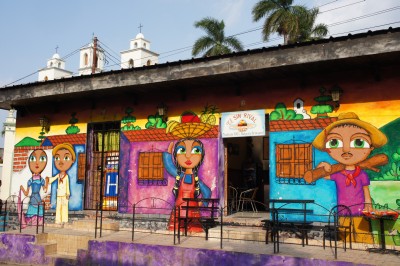
Every weekend there is a food festival in Juayua and the nearby villages. There are about 50 vendors and we enjoyed the softest steak I’ve had in a long time, served with green Chimichurri sauce. We hung out with Allen, a Canadian jew from Toronto who keeps kosher and could not enjoy the fiesta like us.
On Sunday we left Juayua, again sadly saying goodbye to a nice place, and continued climbing. We passed a few lively towns decorated with lovely colourful murals. We enjoyed the food festival in Ataco before dropping down to Ahuachapan, our last stop in lovely El Salvador before crossing to Guatemala.
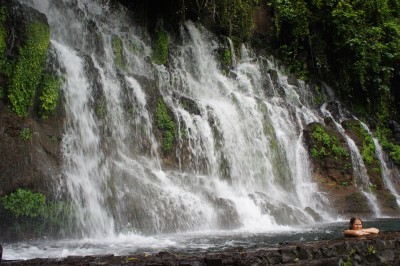
Where Are the Tourists?
We were amazed and surprised by how few foreign tourists we saw in El Salvador. From conversations we had with a few foreigners that live there and run services for tourists, we understood that the situation is pretty gloomy. For some reason tourists are terrified of El Salvador, associating it with a civil war (which ended 20 years ago!), and rampant crime and violence, which rarely affect tourists. I am not sure how much the government is doing to try to improve this image, and it’s true that we even heard from locals that they think it’s dangerous, but we didn’t feel it was any different from other countries we have visited. We kept away from the capital and other big cities. It felt a bit like El Salvador is Central America’s evil step sister. Just that it’s not evil, it’s beautiful, full of natural wonders. So our recommendation is to go and enjoy this country before it is discovered by hordes of tourists.

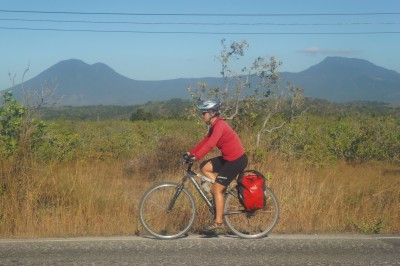

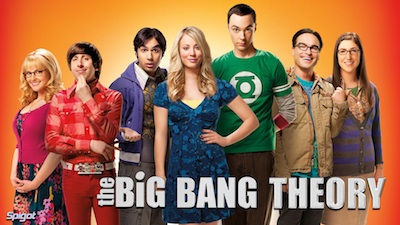
3 Comments
Ann Bardacke
Maya and Gili,
Just don’t be lulled into complacency. I had a friend who was murdered in Guatemala. That said, I have traveled a lot in Mexico and some in Argentina, and I am enjoying your blogs!
Ann
Gili
Thanks, Ann. Sorry about your friend, what happened? Reading the Canadian foreign office’s warnings for most countries in the area is enough to make one’s blood curdle. However, it’s my understanding that tourists are very rarely the targets, and we have certainly felt safe the whole while.
Pingback: